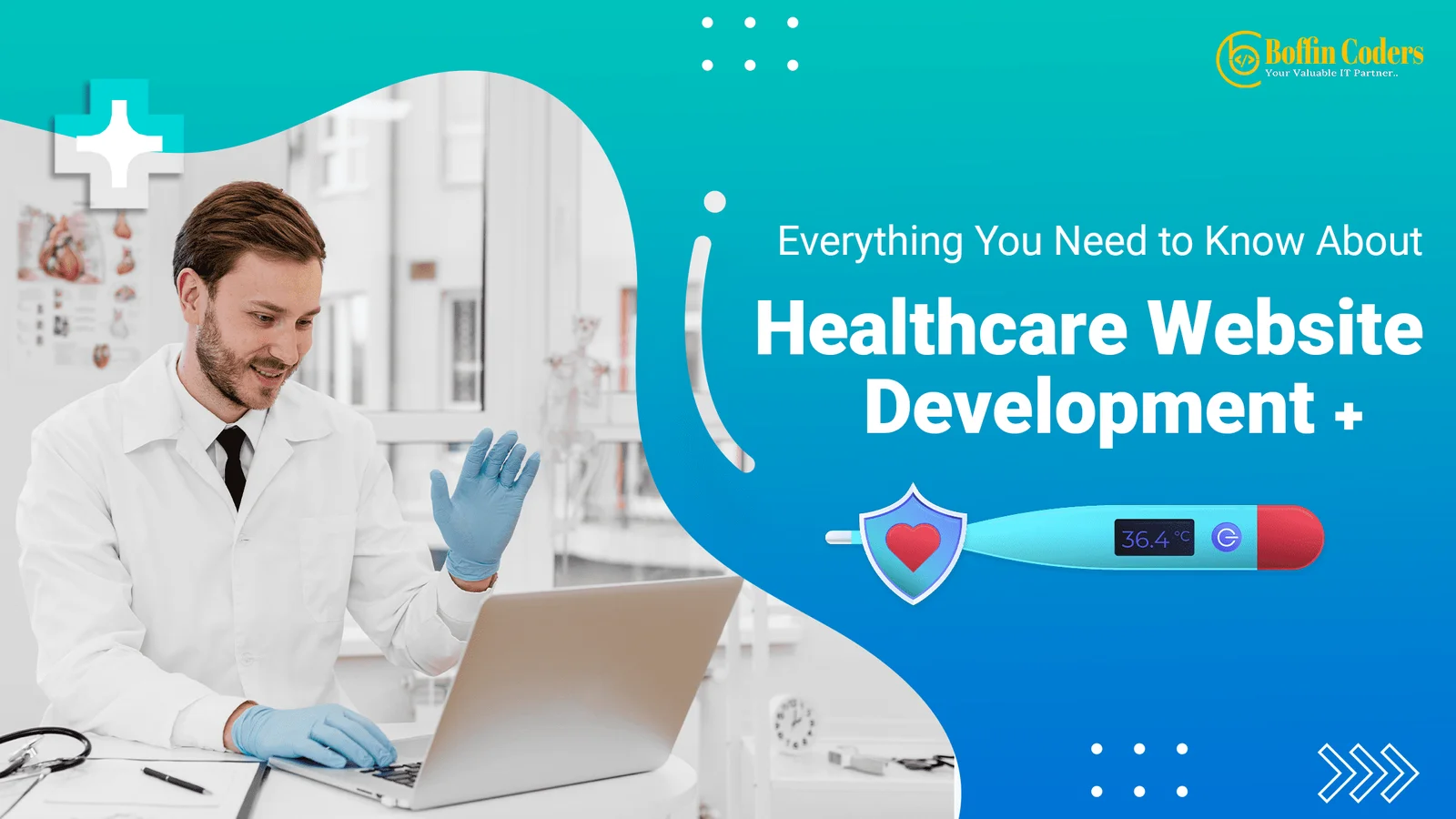In today’s digital era, having a visible online presence is key, particularly in healthcare services. Do you aim to develop a health-focused website, a medical hub, or an online wellness facility? Learning fundamental development concepts is important. Let’s delve into understanding all the required steps to establish a thriving healthcare services website.
Healthcare website development is a specific field of web improvement that focuses on making sites for medical care suppliers, associations, and patients. Medical service sites should be educational, easy to use, and agreeable with HIPAA guidelines.
Why Develop a Medical Services Site?
There are many reasons why medical care suppliers and associations ought to construct a site. A very well-planned site can serve to:
Increment Patient Commitment: A site can furnish patients with data about their well-being, their suppliers, and their treatment choices. It can likewise permit them to plan arrangements, re-order medicines, and speak with their primary care physicians on the web.
Work on Tolerant Results: A site can assist patients with settling on informed conclusions about their medical care. It can likewise furnish them with assets to assist them in dealing with their persistent circumstances and remaining solid.
Construct Believability: An expert site can assist with laying out a medical services supplier or association as a confided-in wellspring of clinical data.
Contact a More Extensive Crowd: A site can help a medical care supplier or association contact a more extensive crowd of expected patients.
Increment Effectiveness: A site can assist with smoothing out regulatory errands and further developing correspondence between medical care suppliers and patients.
Pre-requirement for a Healthcare Website
Here’s a comprehensive guide to the prerequisites for healthcare website development:
1. Easily Define Goals and Identify the Target Audience
Goal: Specifically object to the website’s aims. These could comprise boosting client involvement, amplifying brand recognition, or simplifying managerial duties.
Target Audience: Recognize the main visitors of the website. Keep in mind attributes like their age, role, technical skill, and medical needs.
2. Components and Needs
Fundamental Elements: Guarantee the site incorporates center functionalities like patient data for executives, arrangement planning, secure information, and instructive assets.
Extra Highlights: Consider integrating esteem-added highlights like telehealth administrations, online installment choices, patient criticism reviews, and multilingual help.
3. Consistency with HIPAA Guidelines
HIPAA Mindfulness: Look into the Medical Coverage Conveyability and Responsibility Act (HIPAA) guidelines that safeguard patient protection and information security.
Information Safety Efforts: Execute hearty information safety efforts, including encryption, access controls, and customary security reviews.
4. Specialized Knowledge and Resources
Web Advancement Skill: Draw inexperienced web engineers with ability in medical care web architecture, advancement, and upkeep.
Content Creation: Team up with medical services experts and content scholars to make exact, useful, and satisfactory drawings for the site.
Openness Contemplations: Guarantee the site is open to people with disabilities, complying with Web Content Availability Rules (WCAG).
5. Project The Board and Planning
Project Plan: Foster an exhaustive task plan that frames courses of events, achievements, asset distribution, and financial plan contemplations.
Cost Assessment: Precisely gauge the advancement costs, including web facilitating, upkeep, and any outsider mixes.
Main Features to Integrate During Healthcare Website Development
1. Patient Information Management
A patient gateway permits patients to safely get to and deal with their clinical records, including arrangement history, prescription records, lab results, and charging data. This component advances patient commitment, engages people to assume responsibility for their well-being, and smoothes out managerial undertakings for medical care suppliers.
2. Online Appointment Scheduling
Online appointment scheduling enables patients to schedule appointments 24/7, eliminating the need to call during business hours. This feature enhances patient convenience, reduces wait times, and improves scheduling efficiency for healthcare providers.
3. Secure Information and Correspondence
Secure information provides a helpful stage for patients to discuss straightforwardly with their medical service suppliers, clarify pressing issues, and look for explanations. This component advances patient-supplier correspondence, works with ideal reactions, and adds to a better understanding of results.
4. Telemedicine
Telemedicine permits medical service suppliers to lead virtual discussions with patients, increasing awareness, especially for those in remote or underserved regions. This component gives an option in contrast to face-to-face visits, diminishes travel time and expenses for patients, and improves the availability of medical services.
5. Online Installment Choices
Online installment choices permit patients to pay for arrangements, administrations, and remedies on the web. This component works on tolerant fulfillment, diminishes the requirement for paper charging, and smooths out monetary exchanges for medical care suppliers.
6. Patient Input and Overviews
Patient input overviews give significant bits of knowledge into patient fulfillment, distinguish regions for development, and assist medical care suppliers with improving the general patient experience. This element exhibits a promise of patient-focused care and considers ceaseless quality improvement.
7. Examination and Revealing
Examination and revealing devices furnish medical services suppliers with important information on site use, patient socioeconomics, and arrangement patterns. This data can illuminate showcasing methodologies, further develop site streamlining, and guide vital navigation.
8. Online Payment Options
Online payment options allow patients to conveniently pay for appointments, services, and prescriptions online. This feature improves patient satisfaction, reduces the need for paper billing, and streamlines financial transactions for healthcare providers.
9. Patient Feedback and Surveys
Patient feedback surveys provide valuable insights into patient satisfaction, identify areas for improvement, and help healthcare providers enhance the overall patient experience. This feature demonstrates a commitment to patient-centered care and allows for continuous quality improvement.
10. Analytics and Reporting
Analytics and reporting tools provide healthcare providers with valuable data on website usage, patient demographics, and appointment trends. This information can inform marketing strategies, improve website optimization, and guide strategic decision-making.
Difference Between Health Websites and Medical Websites
Healthcare websites are broader in scope and cater to a wider audience, including patients, healthcare providers, and healthcare organizations. Healthcare websites may also include features like online appointment scheduling, secure messaging, and patient portals.
On the other hand, focuses specifically on providing information about specific medical conditions, diseases, and treatments. They are typically created by medical professionals or organizations, such as hospitals, clinics, or pharmaceutical companies. Medical websites typically contain detailed information about the targeted medical condition, including symptoms, causes, diagnosis, treatment options, and prevention strategies.
The Key Difference Between Health Websites and Medical Websites in 2023:
| Features | Health Website | Medical Website |
| Audience | A broader audience, including individuals seeking general health information, healthcare providers, and healthcare organizations | A narrower audience, primarily patients and healthcare professionals seeking information about specific medical conditions |
| Scope | A comprehensive range of health topics, including general wellness, nutrition, exercise, preventive care, and disease management | Focused on specific medical conditions, diseases, and treatments, providing detailed and in-depth information |
| Content | General health information, lifestyle tips, educational resources, and patient engagement tools | Detailed medical information, including symptoms, causes, diagnosis, treatment options, and clinical trials |
| Purpose | Educate, inform, and empower individuals to make informed health decisions | Provide comprehensive medical information to patients and healthcare professionals to support informed decision-making and clinical practice |
| Ownership | Healthcare providers, healthcare organizations, or individuals | Medical professionals, hospitals, clinics, government agencies, or pharmaceutical companies |
Key Statistics About Healthcare Websites in 2023
- The global healthcare website market is expected to reach $30 billion by 2026.
- 60% of healthcare providers plan to increase their spending on website development in 2023.
- 72% of patients would be more likely to return to a healthcare provider if they could access their medical records online.
- 81% of patients would prefer to schedule appointments online.
- Telemedicine can save healthcare providers up to $6 billion per year.
- Online patient portals can save healthcare providers up to $2 billion per year.
- 94% of Americans turn to the internet and take their health management into their own hands.
- 83% of patients book a doctor’s visit through hospital websites.
- 56% of patients tend to consult three different online sources when searching for a doctor.
Comparing Healthcare Website Costs: USA vs India and Other Countries
Developing a healthcare website’s cost isn’t fixed. It all depends, really. Things like how complicated the site is, what the site needs to do, and where your development team is based can all change it. Generically speaking, it’s usually more expensive to create healthcare sites in the USA than in other countries, like India.
Below is a table summarizing the average costs of developing healthcare websites in the USA vs. India and other countries:
| Region | Average Cost |
| USA | $25,000 – $100,000+ |
| India | $1000 – $5,000 |
| Eastern Europe | $10,000 – $30,000 |
| Latin America | $15,000 – $40,000 |
As you can know, there’s a significant distinction in the average cost of healthcare website growth between the USA and other countries. This is due to a number of factors, including the advanced cost of living and labor in the USA.
Nevertheless, it’s important to note that cost isn’t the only factor to consider when choosing a healthcare website development team. You should also consider the team’s experience, expertise, and capability to meet your specific requirements.
Conclusion
Developing a health website or app requires clear goals, an understanding of the users, a pleasing design, safety, and functionality. By focusing on these essentials, you can create a tool that aids patients and upgrades your health services.
Ready to advance with your health website or app? Think about partnering with Boffin Coders. We are a team of bright, creative folks skilled at crafting solutions for health websites and apps. Let’s create a digital hub to boost patient experiences. Contact us today for a conversation, and let Boffin Coders be the friend who helps your healthcare digital tools succeed!





